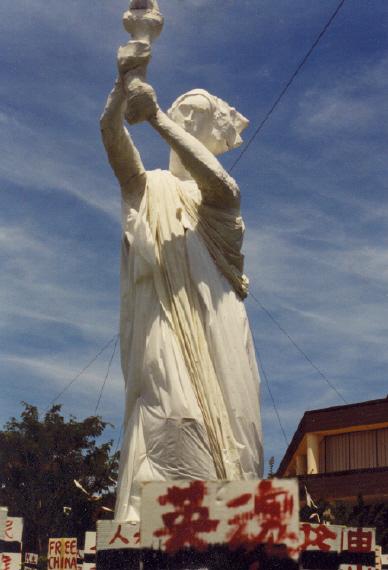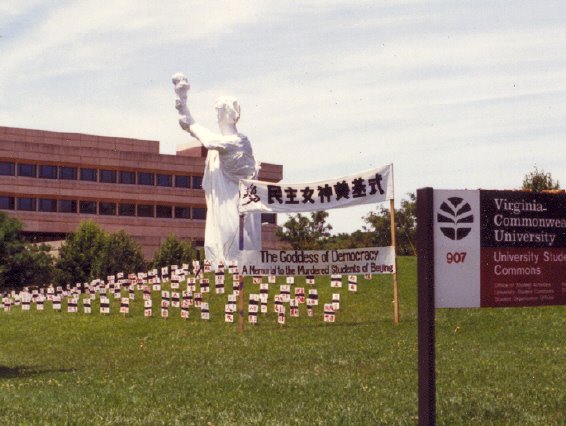
Commentary by F.T. Rea
Built by art students, on May 30, 1989, the Goddess of Democracy was erected in Tiananmen Square as a symbol of their call for democratic reforms in China. The gathering protest in Tiananmen Square had begun in mid-April; tension was mounting.
Subsequently, on June 4, 1989, following orders, the People’s Liberation Army put an end to the demonstration. Mayhem ensued.
Although reports varied widely, hundreds, if not thousands, were killed. Made of chicken wire and plaster the Goddess was destroyed during the brutal routing of the protesters that had remained to the end, in defiance. As the drama played out on television, via satellite, the events shocked the world.
As their art student counterparts in China had been murdered in the shadow of their 33-foot-tall sculpture, in Richmond a group of VCU-affiliated artists heard the call of inspiration to stand with those who had fallen. They knew they had to build a replica of the lost Goddess.
The impromptu team of the willing and able worked around the clock for the next couple of days to give form to their tribute to the courage of those who had perished for freedom of expression. While the project was not sponsored by the school, wisely, VCU did nothing to discourage the gesture.
Richmond’s Goddess of Democracy (pictured above and below) stood the same height and was made of the same basic materials as the one in China had been.
Twenty-three years ago, facing Main Street, it stood as a memorial for about a month in front of the student center. CNN had a report on it, as did many other news agencies. Its image was on front pages of newspapers all over the world.
The little placards on sticks that surrounded the sculpture were added a few days after the Goddess was completed. Art-wise, it was one of the coolest things ever to happen in the Fan District and, to my knowledge, nobody made a penny out of it. It was constructed and maintained entirely by volunteers.
It was also a wonderful illustration of how traditional left and right, liberal and conservative, characterizations of all things political don’t always do justice to the truth of a situation. Was the stubborn and heavy-handed Chinese government standing to the right, or to the left, of the upstart students calling for reform?
When communists are the conservatives clinging to the old way, how does that play out on a spectrum of left-to-right thinking?
In 1989 I couldn't believe the university and the City of Richmond were allowing it. There must have been a thousand regulations and liability concerns that went overlooked, because of the righteousness of the undertaking.
The Goddess of Democracy on VCU’s campus in 1989 was the most successful piece of guerilla art this scribbler can remember having seen.

The June 16 -30, 1989 issue of SLANT ran a story about building of the Goddess, which included the text of a handbill that I found posted at the site of the VCU memorial. Here's part of what it said:
On May 13, 1989, Beijing University students began an occupation of Tiananmen Square to call for democratic reforms and an end to official corruption. The ensuing peaceful and often festive protest drew world attention and gained support from the citizens and workers of Beijing. On Sunday, June 4, at 3:30 [a.m.] Chinese time, troops of the 27th Division of the People’s Liberation Army entered the square with orders to disperse the students. At approximately 6 a.m. these same troops attacked the protestors with automatic weapons, tanks, and bayonets. According to government estimates only 300 students were killed, but local medical estimates put the death toll between 500 and 1,000.
The brutal suppression of unarmed students by a powerful totalitarian government has moved the world’s conscience. Many of the Tiananmen victims were art students who aspired to same basic freedoms which we enjoy daily. As American artists we cannot overlook, and we must never forget, the suffering and sacrifice of our brothers and sisters in Beijing. Their peaceful struggle was a cry for human rights everywhere, and their symbol, the Goddess of Democracy, was the highest artistic tribute they could pay to humanity’s noblest ideal -- freedom.
-- Photos by F.T. Rea
No comments:
Post a Comment